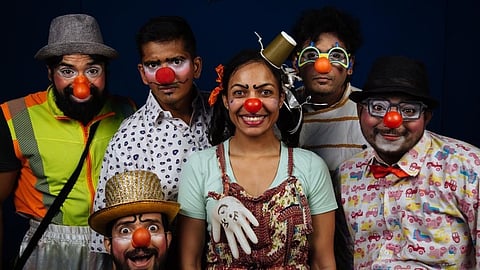

Imagine you’re lying in a stark white hospital bed, tubes attached to your arm, beeping machines surrounding you, and the sterile scent of antiseptic filling the air. A nurse walks in, checks your chart, adjusts your IV, and walks out without much more than a polite nod. Another follows, pressing buttons on a monitor before swiftly leaving. Doctors pass by, discussing cases in hurried tones, their white coats billowing behind them. The walls feel too white, the days too long, and the whole place carries a weight that’s impossible to shake. The air is thick with the quiet hum of illness, the occasional cry from another ward, the distant clatter of a metal tray. And then — just when the atmosphere couldn’t feel heavier — there emerges a clown.
Not the exaggerated, red nosed performer you’d expect at a child’s party, nor the eerie kind from horror films. Instead, this clown is something else entirely — something unexpected, something transformative.
More than just a red nose
“A lot of people think clowns are just about telling jokes and making kids laugh,” says Krishnakumar Balasubramanian (KK), an award-winning theatre artiste and the artistic director of The Little Theatre, Chennai. As the head trainer of India’s first hospital clown troupe, he has spent nearly a decade bringing this unique form of healing to patients across the city. “But that’s far from the truth. Hospital clowning is about restoring control to patients — helping them feel like they have a say in what happens to them, even in the smallest ways.”
The essence of clowning is failure, he explains. Think Tom & Jerry. Tom, tries hard, fails, and keeps going. That struggle, that resilience, is what makes people laugh and, more importantly, makes them root for the clown. In a hospital setting, where patients often feel powerless, this philosophy is transformative. Over the years, KK has trained over 40 professional hospital clowns, shaping a team that seamlessly blends theatre, psychology, and compassion. “The goal isn’t just to entertain. It’s to break down barriers, shift the atmosphere, and remind patients — and even doctors — that they are more than their illness,” he says.
The magic of control
When a hospital clown steps into a patient’s room, every interaction is intentional. “Even entering their space is on their terms,” says KK. “We’ll pretend there’s an invisible doughnut on the door that only opens when the patient says a magic word.” Through stories, games, and tricks, clowns create moments where patients get to make choices — something that’s often stripped away in a hospital setting.
One of the most powerful examples of this happened early on in the programme. KK recalls visiting a young boy in Kauvery Hospital who had just undergone open-heart surgery. He was in immense pain, unable to even drink water, while his mother sat beside him, helpless. The doctors, unsure of what else to do, called in the clowns.
“We started telling him a story, playing a little game. At first, nothing. No reaction,” KK recalls. “Then we introduced a magic word.’ If he said it, something good would happen in the story. At first, he barely whispered it. But by the third time, he shouted it, eyes closed, fully believing in the magic.”
What happened next was nothing short of miraculous. Encouraged by the game, the boy sat up for the first time since his surgery. He took the glass of water from his mother and drank. Behind him, doctors and nurses applauded. In that moment, through storytelling and play, the clowns had done what medicine alone couldn’t — they had made healing feel possible.
Hospital clowning, as a concept, is largely Western. When The Little Theatre introduced it in Chennai in 2015, they had to rethink everything — from the makeup to the mannerisms — to make it culturally relevant. “There’s a real fear of clowns in some people,” says KK. “So we had to find a way to make them approachable, human, yet special. We toned down the exaggerated Western-style makeup, changed the vocabulary we used, and adapted the humour to fit Indian sensibilities.”
It took years of trial and error — understanding how different communities respond to humour, learning which cultural references resonate, and adjusting performances accordingly. Today, the programme is thriving, with trained clowns visiting hospitals weekly, bringing moments of lightness to an otherwise heavy space.
At the end of the day, hospital clowning isn’t just about making people laugh — it’s about making them feel human again. “A hospital treats the body,” KK says. “We treat the spirit.”
And in those sterile hallways, where sickness can feel overwhelming, a little bit of humour goes a long way.